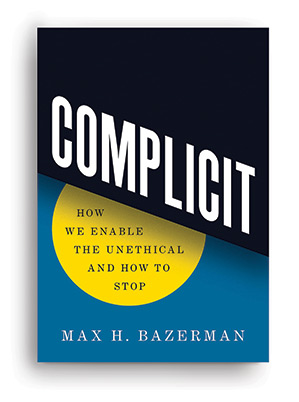A business school professor examines the many flavors of complicity.
By JoAnn Greco

the Unethical and How to Stop
By Max Bazerman W’76
Princeton University Press, $27.95
We often use expressions like “just following orders” or “drinking the Kool-Aid” to tease sycophants. They also come in handy for excusing our own questionable behavior. After all, points out behavioral economist Max Bazerman W’76 in his latest book, Complicit: How We Enable the Unethical and How to Stop, we don’t have to be full-on Nazi sympathizers to be morally culpable for the things we do.
“Many of us face decisions about whether to be complicit in others’ unethical behavior,” he writes in the book’s preface. “Sometimes we assist in less damaging areas … sometimes we help the wrongdoer commit harm more directly.” Bazerman’s aim, he told the Gazette, “is not to relay the stories we already know, but to focus on the secondary casts of characters” to help us realize just how easy it is for ordinary people to become complicit in bad deeds.
Delivering on his assertion that “complicitors always surround the most famous evildoers,” Bazerman examines the people, cultures, and social systems that have enabled a wide variety of wrongdoers to thrive. His case studies range from charismatic corporate ne’er-do-wells like WeWork founder Adam Neumann and Theranos founder Elizabeth Holmes, to more identifiably villainous figures such as Adolf Hitler; police officer Derek Chauvin, the killer of George Floyd; and movie producer and convicted sex offender Harvey Weinstein.
A professor of business administration at Harvard Business School who specializes in negotiations and decision-making, Bazerman has in recent years turned to the ethical aspects of those disciplines. Although most of the stories (and the studies he cites) are drawn from the world of commerce, a handful come from other contexts, including politics.
For example, if thoughts of ‘complicity’ bring to mind Scarlett Johansson as Ivanka Trump sashaying in a gold gown during a Saturday Night Live mock-ad for the perfume “Complicit,” you’re not alone. Bazerman says his 13th book was prompted by President Donald Trump W’68’s attempt to prevent the lawful transfer of power. Case studies of a “true partner” (Steve Bannon) and two “collaborators” (Senators Mitch McConnell and Lindsey Graham) occupy prime real estate in its pages.
These two types of “obvious” complicitors are covered in Part One, which also features appearances by some of the physicians, pharmacies, and distributors that acted as middlemen between opioid manufacturers and their users; and examines governments—think Vichy—that abetted Hitler during the Second World War. These parties are “explicit and intentional” about their alignment with the “core goals of the wrongdoer,” Bazerman writes. True partners succeed if the core wrongdoer succeeds, while collaborators such as the investors who turned a blind eye to the embellishments and feints of Neumann and Holmes are a notch down. They, too, stand to “benefit from the wrongdoer’s behavior . . .[but] these coalitions are often created as a matter of convenience … even when the harm doer has crossed the collaborators’ ethical red lines.”
Yet the bulk of Complicit focuses on subtler instances of “ordinary” complicity, a rubric that collects “implicit, non-deliberative” behaviors such as those exhibited in two examples that Bazerman shares from his own past.
The first involved an epiphany he had while he was writing this book. In early 2021 he received an annual request to nominate fellows to the Academy of Management. A fellow himself, sometimes he nominated a doctoral advisee and sometimes he ignored the request. But as he reflected on his past practice, he became fairly certain that every last one of the nominees he had ever submitted had been white—since all of the students for whom he served as dissertation chair from 1985 to 2000 while at Kellogg School of Management were. (“This hasn’t been true in the new millennium while I’ve been at Harvard,” he notes, “but many of my nominees were from my time at Kellogg.”)
The upshot, of course, was that without any intention—or much reflection—he had reinforced the systemic exclusion of non-white scholars from the upper echelons of his own field.
“I think it’s shockingly common that we nominate people who we know and who therefore may not be all that representative,” he says. “So, I wasn’t evil in that I didn’t have people of color around me—but I was nominating people without thinking about who I was not nominating. It’s that kind of passive neglect that leads to discriminatory patterns that become systematic.”
In a later chapter examining another cause of ordinary complicity—which might be characterized as over-trusting in the ability or integrity of teammates and associates—Bazerman examines a black mark on his own academic career. It stems from a paper that he and four colleagues published in 2012, which was called out for use of fraudulent data while Bazerman was working on this book. “While I did not commit the fraud, I was complicit,” he baldly writes in his introduction to the tale. “My trust was central to my complicity. … I too readily accepted the answers I was given [about the data collection] when I should have pushed even harder.”
“I could have and should have looked over the data myself,” he elaborates in an interview. “I think that if I’d done that, I’d have seen the problem.” In July of 2021, he and the others requested that the paper be retracted. Still, he says, “this terrible episode for an academic who cares passionately about ethics” continues to haunt him.
Bazerman finishes his book by examining the psychological biases behind complicity, which include traits like a propensity to place blame on only a single actor, and failure to grasp that inaction or indirect harm can be just as dangerous as the direct sort. Be on the lookout, in other words, for sins of omission. And although the rather generic (and admittedly broad) solutions he offers for tackling the problem won’t break any ground—they include creating moral organizations and just societies—he does present two more specific ideas. One is that those lower on the totem pole who find themselves being roped into ethical lapses respond by leveraging the power of the group to confront and block them. And leaders, he suggests, should be courageous enough to break the ice when it comes to acknowledging problems—fostering an organizational culture that removes the whistleblowing onus from subordinates alone. Most compelling, though, are his last words, precisely because they are so personal.
“I hope that if I had access in 2011 to the knowledge that I have now about complicity that I would have done more to stop the publication of a paper with fraudulent data,” he writes. The story, he continues, offers a final message.
“When something is wrong, we must not accept the easiest explanation … sometimes this puts our relationships at risk. Sometimes it will be uncomfortable. But it’s the ethical thing to do.”
JoAnn Greco is a Philadelphia journalist.




